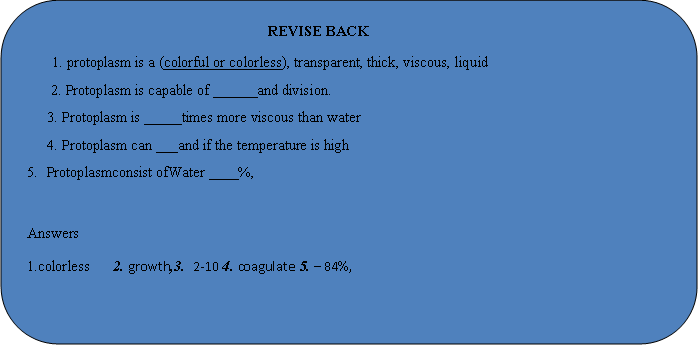PROTOPLASM
Cell of Class 9
It is a colourless, transparent, thick, viscous, liquid. Every animal cell is made up of protoplasm.
The chemical structure of protoplasm was discovered in 1880 by Rodwald and Huxley in 1898, invented that it is primary base of life.
Protoplasm is of two types :
Flow chart of protoplasm showing its constituents
Cytoplasm : This is a colourless, transparent and homogenous mass which is seen between the cell wall and nucleus. It consists of a complex structure and is divided into two.
- Cytoplasmic organelles
- Non-cytoplasmic inclusions
Physical Properties of Protoplasm:
- Growth and division – Protoplasm is capable of growth and division.
- Irritability – Protoplasm is sensitive to different stimuli
- Viscosity – Protoplasm is 2-10 times more viscous than water.
- PH – between 6.5-7.0.
- Elasticity – Protoplasm can be stretched as well as compressed.
- Electricity property – Protoplasm has non-polar, positively charged, negatively charged particles but its electrical conductivity is low.
- Consistency – Protoplasm is slimy semi-fluid with differentiated regions like membranes, organelles etc.
- Transparency – Protoplasm is colourless and transparent but may contain pigmented structures.
- immiscibility with water – Protoplasm does not dissolve in water due to presence of internal and external membranes.
- Density – Protoplasm is heavier than water.
- Selective permeability – Protoplasm maintains its own chemical pool different from that of external environment due to its selective permeability.
- Coagulability – Protoplasm can coagulate and even die if the temperature is high or in presence of radiations, electric currents and electrolytes.
Chemical Composition of Protoplasm
Water – 84%, Proteins – 9%,
Lipids – 2%, Carbohydrates – 2%
DNA – 0.4% RNA – 0.7%
Organic Compounds – 0.4% Inorganic substances 1.4%.

- CELL STRUCTURE
- HISTORICAL BACKGROUND OF CELL
- Cell structure and function
- TYPES OF CELL & ORGANISM
- DETAILED STRUCTURE OF CELL
- CELL MEMBRANE
- CELL WALL
- PROTOPLASM
- NUCLEUS
- CYTOPLASM
- ENDOPLASMIC RETICULUM
- GOLGI APPARATUS
- LYSOSOMES (ENZYMES PACKETS)
- MITOCHONDRIA
- RIBOSOMES
- PLASTID
- VACUOLES (NON-CYTOPLASMIC INCLUSIONS)
- PEROXISOMES
- CELL DIVISION
- solved question
- Exercise 1 for Cell of class 11
- Exercise 2 for Cell
- Exercise3 for Cell of class 11
- Exercise 4(Fill in the blanks) for Cell of class 11
- Exercise 5(True-False) for Cell of class 11









